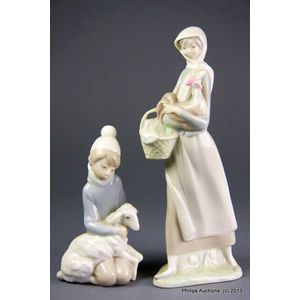Royal Worcester Egyptian Musician Figurine by Hadley
You must be a subscriber, and be logged in to view price and dealer details.
Subscribe Now to view actual auction price for this item
When you subscribe, you have the option of setting the currency in which to display prices to $Au, $US, $NZ or Stg.
- Circa - A Latin term meaning 'about', often used in the antique trade to give an approximate date for the piece, usually considered to be five years on either side of the circa year. Thus, circa 1900 means the piece was made about 1900, probably between 1895 and 1905. The expression is sometimes abbreviated to c.1900.
- Ivory - Ivory is a hard white material that comes from the tusks of elephants, mammoth, walrus and boar, or from the teeth of hippopotamus and whales. The ivory from the African elephant is the most prized source of ivory. Although the mammoth is extinct, tusks are still being unearthed in Russia and offered for sale.
Ivory has been used since the earliest times as a material for sculpture of small items, both in Europe and the east, principally China and Japan.
In Asia ivory has been carved for netsuke, seals, okimono, card cases, fan supports, animals and other figures and even as carved tusks.
In the last 200 years in Europe ivory has been used to carve figures, for elaborate tankards, snuff boxes, cane handles, embroidery and sewing accessories, in jewellery and as inlay on furniture. Its more practical uses include being used for billiard balls, buttons, and a veneers on the top of piano keys.
The use and trade of elephant ivory have become controversial because they have contributed to Due to the decline in elephant populations because of the trade in ivory, the Asian elephant was placed on Appendix One of the Convention on International Trade in Endangered Species (CITES), in 1975, and in January 1990, the African elephant was similarly listed. Under Appendix One, international trade in Asian or African elephant ivory between member countries is forbidden. Unlike trade in elephant tusks, trade in mammoth tusks is legal.
Since the invention of plastics, there have been many attempts to create an artificial ivory - Lyre Motif - The lyre motif is an ancient decorative design that is believed to have originated in ancient Greece, where the lyre was a popular musical instrument. The lyre itself was often decorated with ornate carvings and designs, including the iconic lyre motif.
In ancient Greek mythology, the lyre was associated with the god Apollo, who was the patron of music and the arts. The lyre was said to have been invented by the god Hermes, who presented it to Apollo as a gift. As a result, the lyre became a symbol of creativity, inspiration, and artistic expression.
The lyre motif typically features a curved or S-shaped body, with strings extending upwards from the base. The motif was often used in architectural decoration, as well as on pottery, jewellery, and other decorative objects.
This item has been included into following indexes:
- Hadley's Worcester (England) - ceramics 158
- Hadley, James - Royal Worcester artists 120
- Royal Worcester (England), item types
Visually similar items

Two Lladro porcelain figurines, including a 'shepherd boy with Lamb', catalogue number 4676, introduced in 1970 and designed by Juan Huerta; and 'Girl with Cockerel', catalogue number 4591, introduced in 1970 and designed by Fulgencio Garcia; both stamped

A signed antique ivory okimono of a woman and child, Meiji period, later 19th century, depicting the figure of a woman in a kimono and with well coiffed hair, holding a staff and balancing an animated small child with her right hand upon her hip; upon a ci

A signed antique ivory okimono of a fisherman, early 20th century, a contemplative fisherman with his net and a pipe, lightly engraved and inked, with natural age related fissures, signed with two characters in red underside, height 17 cm

A fine Royal Worcester Bringaree Indian figurine, circa 1887, the blushware figure in draped and girdled attire posed with a staff and hand on hip, the drapery beautifully detailed with muted hues and gold highlights, upon a circular base; stamps and impre
